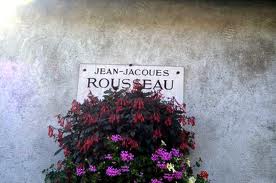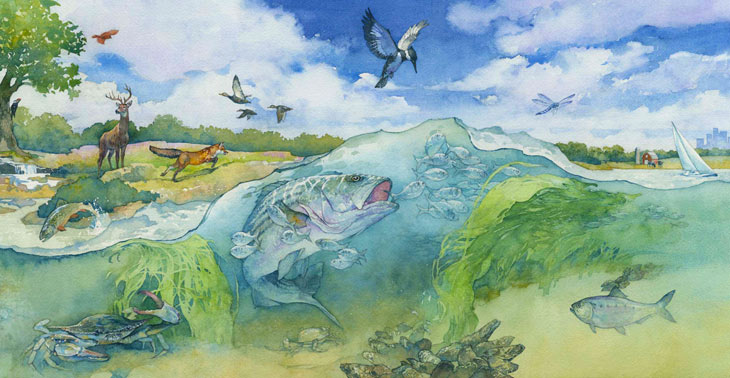Dr. V.K.Maheshwari, M.A. (Socio, Phil) B.Sc. M. Ed, Ph.D.
Former Principal, K.L.D.A.V.(P.G) College, Roorkee, India
Mrs Sudha Rani Maheshwari, M.Sc (Zoology), B.Ed.
Former Principal, A.K.P.I.College, Roorkee, India
Descartes was born on 31 March 1596 in La Haye, in the Touraine region of France. His father Joachim, a lawyer. In 1606, at the age of 8, René attended the Jesuit college of Henri IV in La Flèche, where he studied literature, grammar, science, and mathematics. In 1614, he left La Flèche to study civil and cannon Law at Poitiers. In 1616, he received his baccalaureate and licentiate degrees in Law. Aside from his Law degrees, Descartes also spent time studying philosophy, theology, and medicine.
Descartes was a “jack of all trades”, making major contributions to the areas of anatomy, cognitive science, optics, mathematics and philosophy. Descartes, like Bacon, resolutely sets his face against the old authorities and, like him, emphasizes the practical character of all philosophy. Philosophy is a perfect knowledge of all that man can know, as well for the conduct of his life as for the preservation of his health and the discovery of all the arts.” René Descartes is often credited with being the “Father of Modern Philosophy.” This title is justified due both to his break with the traditional Scholastic-Aristotelian philosophy prevalent at his time and to his development and promotion of the new, mechanistic sciences. His fundamental break with Scholastic philosophy was twofold. René Descartes, French mathematician, scientist, and philosopher. Because he was one of the first to abandon scholastic Aristotelianism, because he formulated the first modern version of mind-body dualism, from which stems the mind-body problem, and because he promoted the development of a new science grounded in observation and experiment, he has been called the father of modern philosophy. Applying an original system of methodical doubt, he dismissed apparent knowledge derived from authority, the senses, and reason and erected new epistemic foundations on the basis of the intuition that, when he is thinking, he exists; this he expressed in the dictum “I think, therefore I am” (best known in its Latin formulation, “Cogito, ergo sum,” though originally written in French, “Je pense, donc je suis”). He developed a metaphysical dualism that distinguishes radically between mind, the essence of which is thinking, andmatter, the essence of which is extension in three dimensions. Descartes’s metaphysics is rationalist, based on the postulation of innate ideas of mind, matter, and God, but his physics and physiology, based on sensory experience, are mechanistic and empiricist.,
Descartes implying that he provided the seed for a new philosophy that broke away from the old in important ways. This “old” philosophy is Aristotle’s as it was appropriated and interpreted throughout the later medieval period. In fact, Aristotelianism was so entrenched in the intellectual institutions of Descartes’ time that commentators argued that evidence for its the truth could be found in the Bible. Accordingly, if someone were to try to refute some main Aristotelian tenet, then he could be accused of holding a position contrary to the word of God and be punished. However, by Descartes’ time, many had come out in some way against one Scholastic-Aristotelian thesis or other. So, when Descartes argued for the implementation of his modern system of philosophy, breaks with the Scholastic tradition were not unprecedented. With the Greek thinkers of the classical period and many of the great philosophers who came after him, Descartes emphasizes the practical, ethical significance of philosophy : ” The study of philosophy is more imperatively requisite for the regulation of our manners and for conducting us through life than is the use ef our eyes for directing our steps.”
In the preface to the French edition of the Principles of Philosophy, Descartes uses a tree as a metaphor for his holistic view of philosophy. “The roots are metaphysics, the trunk is physics, and the branches emerging from the trunk are all the other sciences, which may be reduced to three principal ones, namely medicine, mechanics and morals” (AT IXB 14: CSM I 186) .Metaphysics constitutes the roots securing the rest of the tree. For it is in Descartes’ metaphysics where an absolutely certain and secure epistemological foundation is discovered. This, in turn, grounds knowledge of the geometrical properties of bodies, which is the basis for his physics. Second, physics constitutes the trunk of the tree, which grows up directly from the roots and provides the basis for the rest of the sciences. Third, the sciences of medicine, mechanics and morals grow out of the trunk of physics, which implies that these other sciences are just applications of his mechanistic science to particular subject areas. Finally, the fruits of the philosophy tree are mainly found on these three branches, which are the sciences most useful and beneficial to humankind. However, an endeavor this grand cannot be conducted haphazardly but should be carried out in an orderly and systematic way. Hence, before even attempting to plant this tree, Descartes must first figure out a method for doing so. First, Descartes thought that the Scholastics’ method was prone to doubt given their reliance on sensation as the source for all knowledge. Second, he wanted to replace their final causal model of scientific explanation with the more modern, mechanistic mode. The first part of true philosophy, according to Descartes, is metaphysics, In metaphysics, he provided arguments for the existence of God, to show that the essence of matter is extension, and that the essence of mind is thought. The metaphysical objects of investigation included the existence and nature of God and the soul (1:144, 182). Metaphysics contains the principles of knowledge, such as the definition of the principal attributes of God, Classification the immateriality of the soul, and of all the clear Sciences and simple notions that are in us. The second is physics, in which, after finding the true principles of material things, we examine, in general, how the whole universe has been framed; then, in particular, the nature of the earth and of all the bodies most generally found upon it, as air, water, fire, the loadstone and other minerals ; next the nature of plants, animals, and, above all, man, in order hereafter to be able to discover the other sciences that are useful to us. Thus, all philosophy is like a tree, of which metaphysics is the root, physics the trunk, and all the other sciences the branches that grow out of this trunk, which are reduced to three principal, namely, medicine, mechanics, and ethics. The science of morals is the highest and most perfect, which, presupposing an entire knowledge of the other sciences, is the last degree of wisdom.
Physics
Descartes devised a non-atomistic, mechanistic physics in which all physical phenomena were to be explain by the configuration and motion of a body’s miniscule parts. Descartes, thought human effort is better directed toward the discovery of the mechanistic causes of things given the uselessness of final causal explanations and how it is vain to seek God’s purposes. Furthermore, Descartes maintained that the geometric method should also be applied to physics so that results are deduced from the clear and distinct perceptions of the geometrical or quantifiable properties found in bodies, that is, size, shape, motion, determination (or direction), quantity, and so forth.
Since the matter constituting the physical universe and its divisibility were previously discussed, a brief explanation of the circular motion of bodies and the preservation of motion is in order. The first thesis is derived from God’s immutability and implies that no quantity of motion is ever added to or subtracted from the universe, but rather quantities of motion are merely passed from one body to another. God’s immutability is also used to support the first law of motion, which is that each and everything, in so far as it can, always continues in the same state; and thus what is once in motion always continues in motion. This principle indicates that something will remain in a given state as long as it is not being affected by some external cause. So a body moving at a certain speed will continue to move at that speed indefinitely unless something comes along to change it. The second thesis about the circular motion of bodies is discussed at Principles, part II, section 33. This claim is based on the earlier thesis that the physical universe is a plenum of contiguous bodies. On this account, one moving body must collide with and replace another body, which, in turn, is set in motion and collides with another body, replacing it and so on. But, at the end of this series of collisions and replacements, the last body moved must then collide with and replace the first body in the sequence.
Descartes’ second law of motion is that “all motion is in itself rectilinear; and hence any body moving in a circle always tends to move away from the center of the circle which it describes” This is justified by God’s immutability and simplicity in that he will preserve a quantity of motion in the exact form in which it is occurring until some created things comes along to change it. The principle expressed here is that any body considered all by itself tends to move in a straight line unless it collides with another body, which deflects it.
The third general law of motion, in turn, governs the collision and deflection of bodies in motion. This third law is that “if a body collides with another body that is stronger than itself, it loses none of its motion; but if it collides with a weaker body, it loses a quantity of motion”). This law expresses the principle that if a body’s movement in a straight line is less resistant than a stronger body with which it collides, then it won’t lose any of its motion but its direction will be changed. But if the body collides with a weaker body, then the first body loses a quantity of motion equal to that given in the second.
Method
Unlike the English empiricist, how- ever, he takes mathematics as the model of his philosophical method: study logic, he tells us, and practise its rules by studying mathematics. He offers not merely a program of human knowledge, but seeks to construct a system of thought that may possess the certainty of mathematics Descartes sought to avoid these difficulties through the clarity and absolute certainty of geometrical-style demonstration. In geometry, theorems are deduced from a set of self-evident axioms and universally agreed upon definitions. Accordingly, direct apprehension of clear, simple and indubitable truths (or axioms) by intuition and deductions from those truths can lead to new and indubitable knowledge. Descartes found this promising for several reasons. First, the ideas of geometry are clear and distinct, and therefore they are easily understood unlike the confused and obscure ideas of sensation. Second, the propositions constituting geometrical demonstrations are not probabilistic conjectures but are absolutely certain so as to be immune from doubt. This has the additional advantage that any proposition derived from some one or combination of these absolutely certain truths will itself be absolutely certain. Hence, geometry’s rules of inference preserve absolutely certain truth from simple, indubitable and intuitively grasped axioms to their deductive consequences unlike the probable syllogisms of the Scholastics.
Descartes claimed early on to possess a special method, which was variously exhibited in mathematics, natural philosophy, and metaphysics, and which, in the latter part of his life, included, or was supplemented by, a method of doubt.
Descartes was known among the learned in his day as the best of the French mathematicians, as the developer of a new physics, and as the proposer of a new metaphysics. In the years following his death, his natural philosophy was widely taught and discussed. In the eighteenth century aspects of his science remained influential, especially his physiology, and he was remembered for his failed metaphysics and his method of doubt. In the nineteenth century he was revered for his mechanistic physiology and theory that animal bodies are machines (that is, are constituted by material mechanisms, governed by the laws of matter alone). The twentieth century variously celebrated his famous “cogito” starting point, reviled the sense data that some alleged to be the legacy of his skeptical starting point, and looked to him as a model of the culturally engaged philosopher. He has been seen, at various times, as a hero and as a villain; as a brilliant theorist who set new directions in thought, and as the harbinger of a cold, rationalistic, and calculative conception of human beings.
Descartes invented analytic geometry, a method of solving geometric problems algebraically and algebraic problems geometrically. He also devised a universal method of deductive reasoning, based on mathematics, that is applicable to all the sciences. This method, which he later formulated in Discourse on Method (1637) and Rules for the Direction of the Mind consists of four rules: (1) accept nothing as true that is not self-evident, (2) divide problems into their simplest parts, (3) solve problems by proceeding from simple to complex, and (4) recheck the reasoning. These rules are a direct application of mathematical procedures. In addition, Descartes insisted that all key notions and the limits of each problem must be clearly defined. In the Rules, he sought to generalize the methods of mathematics so as to provide a route to clear knowledge of everything that human beings can know. His methodological advice included a suggestion that is familiar to every student of elementary geometry: break your work up into small steps that you can understand completely and about which you have utter certainty, and check your work often. But he also had advice for the ambitious seeker of truth, concerning where to start and how to work up to greater things. Thus, Rule 10 reads: “In order to acquire discernment we should exercise our intelligence by investigating what others have already discovered, and methodically survey even the most insignificant products of human skill, especially those which display order” . As examples of “simple” arts “in which order prevails,” he offered carpet-making and embroidery, and also number-games and arithmetic games. He went on to discuss the roles of the “cognitive faculties” in acquiring knowledge, which include the intellect, imagination, sense perception, and memory. These faculties allow the seeker of knowledge to combine simple truths in order to solve more complex problems, such as the solution to problems in optics (10:394), or the discovery of how a magnet works (10:427).
By the end of 1628 Descartes had abandoned work on the Rules, having completed about half of the projected treatise.
Cogito, ergo sum
In the Second Meditation, Descartes tries to establish absolute certainty in his famous reasoning: Cogito, ergo sum or “I think, therefore I am.” These Meditations are conducted from the first person perspective, from Descartes.’ However, he expects his reader to meditate along with him to see how his conclusions were reached. This is especially important in the Second Meditation where the intuitively grasped truth of “I exist” occurs. So the discussion here of this truth will take place from the first person or “I” perspective. All sensory beliefs had been found doubtful in the previous meditation, and therefore all such beliefs are now considered false. This includes the belief that I have a body endowed with sense organs. But does the supposed falsehood of this belief mean that I do not exist? No, for if I convinced myself that my beliefs are false, then surely there must be an “I” that was convinced. Moreover, even if I am being deceived by an evil demon, I must exist in order to be deceived at all. So “I must finally conclude that the proposition, ‘I am,’ ‘I exist,’ is necessarily true whenever it is put forward by me or conceived in my mind” (AT VII 25: CSM II 16-17). This just means that the mere fact that I am thinking, regardless of whether or not what I am thinking is true or false, implies that there must be something engaged in that activity, namely an “I.” Hence, “I exist” is an indubitable and, therefore, absolutely certain belief that serves as an axiom from which other, absolutely certain truths can be deduced.
But one thing is certain, and that is that I doubt, or think; of that there can be no doubt. And it is a contradiction to conceive that that which thinks does not exist at the very time when it thinks. Descartes does not here infer from an empirical psychical fact: I think, hence I am; but reasons logically that doubt implies a doubter, thinking a thinker, a thinking thing (res cogitans) or spiritual substance; thus reaching what seems to him a rational, self-evident proposition. To doubt means to think, to think means to be ; cogito, ergo sum, I think, therefore I am. ” It is the first and most certain knowledge that occurs to one who philosophizes in an orderly manner.” Here is the principle we have been seeking, a certain, self-evident starting- point for our metaphysics.
Nature and Body
In his conception of external nature, he is in agreement with the great natural scientists of the new era : everything in nature, even physiological processes and emotions, must be explained mechanically, without the aid of forms or essences. At the same time, he accepts the fundamental principles of the time-honored idealistic or spiritualistic philosophy and attempts to adapt them to the demands of the new science: his problem is to reconcile mechanism and the notions of God, soul, and freedom.
All the processes of the external world are modifications or modes of extension ; extension may be divided without end, the parts may be united and separated, whence arise different forms of matter. All variation of matter, or diversity of form, depends on motion. Motion is the action by which a body passes from one place to another. It is a mode of the movable thing, not a substance. All occurrence is transference of motion from one part of space to another. ” Motion is the transporting of one part of matter or of one body from the vicinity of those bodies that are in immediate contact with it, or which we regard at rest, to the vicinity of other bodies.” The physical world is explained in terms of mechanics. There is no action in the distance, all occurrences are due to pressure and impact. Hence, there must be a universal ether to account for the facts of astronomy.
Body conceived as mere extension is passive and cannot move itself; we must, therefore, have recourse to God as the first cause of motion in the world. ” God originally created matter along with motion and rest, and now by his concourse alone preserves in the whole the same amount of motion that he then placed in it.” This view of the prime mover was common in the time of Descartes and after. Galileo and Newton both accepted it : it is the old Aristotelian conception.) 1 To hinder divine interference with the world, however, which would mean the abandonment of the mechanical theory and a relapse into scholasticism, our philosopher holds that God has given the world a certain amount of motion : motion is constant. We have here the theory of the conservation of energy in germ. Bodies can not produce motion of themselves or stop it ; consequently, they can neither increase nor decrease it, and hence the quantity of motion and rest must remain the same.
What particularly attracted Descartes in this extreme dualism was that it left nature free for the mechanical explanations of natural science. Mind is eliminated from nature and given an independent territory of its own. Physics is allowed to go its own way ; all purposes or final causes are banished from it. A division is made between mind and body similar to the division made between theology and philosophy in scholastic days. This teaching Descartes applies to the entire organic world, even to the human body. The human body is, like the animal body, a machine. The moving principle in it is the heat in the heart; the organs of motion are the muscles; the organs of sensation, the nerves. Animal spirits are distilled in the blood in the heart and rise through the arteries into the brain, and thence into the muscles and nerves. All the functions of the body follow naturally, in this machine, from the arrangement of the organs, as necessarily as the movements of a watch or other automaton follow from its pendulum and wheels. It is not necessary to conceive in it any plant or sensitive soul or any other principle of vital motion than blood and the animal spirits. Descartes repudiates the vitalism of Aristotle and the schoolmen, and offers a thoroughgoing mechanical theory of organic nature.
If these two substances exclude one another, it would follow that there can be no interaction between them: mind cannot cause changes in the body, and body cannot cause changes in the mind. Descartes, however, does not draw the consequences of his premises. There are certain facts which point to an intimate union between body and mind in man : appetites of hunger and thirst ; emotions and passions of mind which are not exclusively mental affections; sensations of pain, color, light, sound, etc. These we cannot refer to the body alone or to the soul alone, but must explain by the close and intimate union of the two. The union is not to be conceived as one like that of the pilot to the vessel. My mind and my body compose a substantial unity. All the sensations just mentioned are merely confused modes of consciousness, the result of this union. That is, man is not a pure spirit. Motion in animals, and often in ourselves, occurs without the intervention of reason ; the senses excited by external objects simply react to the animal spirits and the reactions are mechanical, the animal is nothing but a machine ; but this is not the case with human sensations. If I were merely a thinking being, if my soul were not somehow intimately conjoined with my body, I should, for example, know that I am hungry, but not feel hungry. I should not have these confused modes of consciousness.
Just how this intimate union is to be conceived, is not made quite clear, however. Descartes warns us against confounding mind and body with one another. Thought and extension, he tells us, can be combined, in man, in unity of composition, but not in unity of nature : the union should not be compared with a mixture of two bodies. He teaches that ” thought can be troubled by the organs without being the product of them “; sensations, feelings, and appetites are disturbances in the soul resulting from its union with a body. In spite of the union, however, body and soul remain distinct; God has put them together; he cannot rid himself of the power of separating them or of conserving the one apart from the other. Descartes ‘s idea here seems to be that the relation between mind and body is not such that a physical state becomes a mental state, produces or causes a mental state, or vice versa : the mind is simply troubled by organic processes. His obscurity and vacillation on this point are due to his desire to explain the corporeal world on purely mechanical principles and at th same time leave a place for the action of a spiritual principle. The facts of experience point to an intimate connection between the two worlds which his elearcut distinction between them seems to render impossible.
At other times, however, he accepts the theory of causal inter action without hesitation. The soul, though united with the whole body, exercises its functions more particularly, or has its principal seat, in the pineal gland of the brain. Movements are caused by sensible objects in the animal spirits and transferred to the pineal gland ; in this way sensations are produced.
The soul can also move the gland in different ways ; this motion is transferred to the animal spirits and conducted by them over the nerves into the muscles. Here the relation of mind and body is clearly conceived as causal : through the mediation of the pineal gland a certain interaction is brought about between them.
It is also important to notice that the mind is a substance and the modes of a thinking substance are its ideas. For Descartes a substance is a thing requiring nothing else in order to exist. Hence the mind is an immaterial thinking substance, while its ideas are its modes or ways of thinking.
Mind is better known than the body. This is the main point of the wax example found in the Second Meditation. Here, Descartes pauses from his methodological doubt to examine a particular piece of wax fresh from the honeycomb:
It has not yet quite lost the taste of the honey; it retains some of the scent of flowers from which it was gathered; its color shape and size are plain to see; it is hard, cold and can be handled without difficulty; if you rap it with your knuckle it makes a sound. (AT VII 30: CSM II 20)
The point is that the senses perceive certain qualities of the wax like its hardness, smell, and so forth. But, as it is moved closer to the fire, all of these sensible qualities change. “Look: the residual taste is eliminated, the smell goes away, the color changes, the shape is lost, the size increases, it becomes liquid and hot” (AT VII 30: CSM II 20). However, despite these changes in what the senses perceive of the wax, it is still judged to be the same wax now as before. To warrant this judgment, something that does not change must have been perceived in the wax.
Descartes enumerates six primary passions : wonder, love, hate, desire, joy, and sorrow, of which all the rest are species. They are all related to the body; their natural use being to incite the soul to consent and contribute to the actions which tend to preserve the body or to render it in some way more perfect; and in this sense joy and sorrow are the first to be employed. For the soul is directly turned from harmful things only by the feeling of pain, which produces the passion of sorrow, then follow hatred of the cause of the pain and the desire to be freed from the pain.
Our good and evil depend chiefly on the inner emotions excited in the soul only by the soul itself. So long as the soul has something within to satisfy it, all the troubles which come from without have no power to hurt it. And in order that it may have this inner satisfaction, all that is needed is to follow virtue exactly. We note here the Stoic influence on Descartes ‘s ethics. Stoicism was the current ethical theory in the Renaissance and remained popular far into modern times.
This reasoning establishes at least three important points. First, all sensation involves some sort of judgment, which is a mental mode. Accordingly, every sensation is, in some sense, a mental mode, and “the more attributes [that is, modes] we discover in the same thing or substance, the clearer is our knowledge of that substance” (AT VIIIA 8: CSM I 196). Based on this principle, the mind is better known than the body, because it has ideas about both extended and mental things and not just of extended things, and so it has discovered more modes in itself than in bodily substances. Second, this is also supposed to show that what is unchangeable in the wax is its extension in length, breadth and depth, which is not perceivable by the senses but by the mind alone. The shape and size of the wax are modes of this extension and can, therefore, change. But the extension constituting this wax remains the same and permits the judgment that the body with the modes existing in it after being moved by the fire is the same body as before even though all of its sensible qualities have changed. One final lesson is that Descartes is attempting to wean his reader from reliance on sense images as a source for, or an aid to, knowledge. Instead, people should become accustomed to thinking without images in order to clearly understand things not readily or accurately represented by them, for example, God and the mind. So, according to Descartes, immaterial, mental things are better known and, therefore, are better sources of knowledge than extended things.
The idea of God
The idea of God we have received from God ; it is innate. God is not only the cause, but the archetype of our existence, he has created man in his own image. It ought not to be wondered at that God in creating me should have placed this idea in me, to serve as the mark of the workman imprinted on his work. “If God did not exist, I could not possibly be what I am, nor could I have an idea of God. We know more of God himself and of the human mind than we know of corporeal objects. Reflecting upon the idea of God, we perceive that he is eternal, omniscient, omnipotent, the source of all goodness and truth ; the creator of all things. He is not corporeal and does not perceive by means of the senses, as we do. He has intellect and will, but not like ours ; and he does not will evil or sin, for sin is the negation of being”.
According to Descarte,it is also unthinkable that the divine perfections, which we conceive, should have more than one cause, for if these causes were many, they would not be perfect ; to be perfect there must be one cause only, one God. God must be self-caused, for if he is the effect of another being, then that being is the effect of another, and so on ad infinitum: we have an infinite regress and never reach any effect.
We have thus far discovered several self-evident truths: I exist ; Whatever is clearly and distinctly perceived is true ; Nothing can be without a cause; The cause must contain at least as much reality and perfection as the effect; God exists; God is perfect, God cannot deceive us. But how comes it, then, that we are ever deceived, that we ever err at all? In the first place, the power of distinguishing the true from Error & the false, which God has given us, is not infinite.
Moreover, error .depends on the concurrence of two causes, namely, the faculty of recognition and the faculty of election, or the power of free choice, i.e., understanding and will. By understanding alone, we neither affirm nor deny anything, but merely apprehend the ideas regarding which we may form a judgment; no error, properly so-called, is found in it. Neither is the will of itself the source of error, for it is exceedingly ample and perfect in its kind. Errors are due to my failure to restrain the will from judging a thing when we do not conceive it with sufficient clearness and distinctness; by choosing the false in- stead of the true and evil instead of good, the will falls into error and sin.
The ontological argument is found in the Fifth Meditation and follows a more straightforwardly geometrical line of reasoning. Here Descartes argues that God’s existence is deducible from the idea of his nature just as the fact that the sum of the interior angles of a triangle are equal to two right angles is deducible from the idea of the nature of a triangle. The point is that this property is contained in the nature of a triangle, and so it is inseparable from that nature. Accordingly, the nature of a triangle without this property is unintelligible. Similarly, it is apparent that the idea of God is that of a supremely perfect being, that is, a being with all perfections to the highest degree. Moreover, actual existence is a perfection, at least insofar as most would agree that it is better to actually exist than not. Now, if the idea of God did not contain actual existence, then it would lack a perfection. Accordingly, it would no longer be the idea of a supremely perfect being but the idea of something with an imperfection, namely non-existence, and, therefore, it would no longer be the idea of God. Hence, the idea of a supremely perfect being or God without existence is unintelligible. This means that existence is contained in the essence of an infinite substance, and therefore God must exist by his very nature.
God’s existence from intuitively grasped premises, thereby providing, a glimmer of hope of extricating himself from the evil demon scenario. The next step is to demonstrate that God cannot be a deceiver. At the beginning of the Fourth Meditation, Descartes claims that the will to deceive is “undoubtedly evidence of malice or weakness” so as to be an imperfection. But, since God has all perfections and no imperfections, it follows that God cannot be a deceiver. For to conceive of God with the will to deceive would be to conceive him to be both having no imperfections and having one imperfection, which is impossible; it would be like trying to conceive of a mountain without a valley
This means that God cannot be the cause of human error, since he did not create humans with a faculty for generating them, nor could God create some being, like an evil demon, who is bent on deception. Rather, humans are the cause of their own errors when they do not use their faculty of judgment correctly. Second, God’s non-deceiving nature also serves to guarantee the truth of all clear and distinct ideas. So God would be a deceiver, if there were a clear and distinct idea that was false, since the mind cannot help but believe them to be true. Hence, clear and distinct ideas must be true on pain of contradiction.
But this veridical guarantee gives rise to a serious problem within the Meditations, stemming from the claim that all clear and distinct ideas are ultimately guaranteed by God’s existence, which is not established until the Third Meditation. This means that those truths reached in the Second Meditation, such as “I exist” and “I am a thinking thing,” and those principles used in the Third Meditation to conclude that God exists, are not clearly and distinctly understood, and so they cannot be absolutely certain. Hence, since the premises of the argument for God’s existence are not absolutely certain, the conclusion that God exists cannot be certain either. This is what is known as the “Cartesian Circle,” because Descartes’ reasoning seems to go in a circle in that he needs God’s existence for the absolute certainty of the earlier truths and yet he needs the absolute certainty of these earlier truths to demonstrate God’s existence with absolute certainty.
























